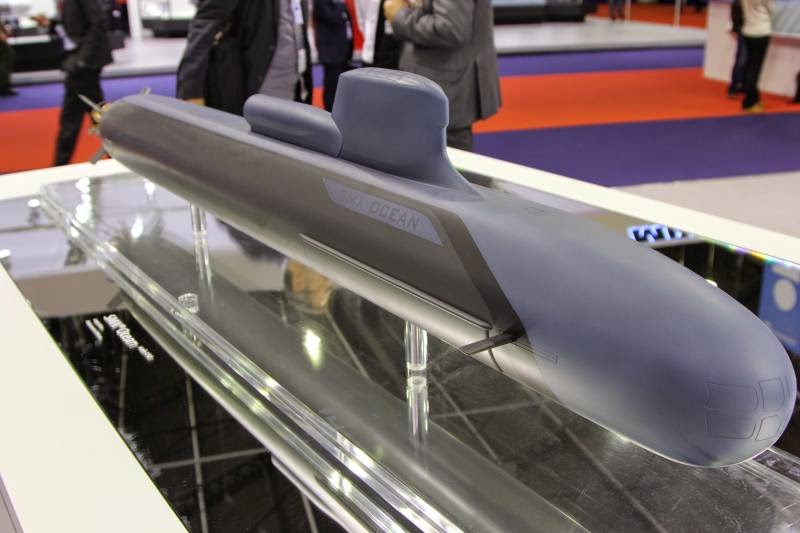DCNS unveiled the SMX®-Océan conventionally powered attack submarine. The new vessel draws extensively on the design of a state-of-the-art nuclear- powered submarine, with a number of key innovations that give this diesel-electric adaptation truly outstanding performance. DCNS is a French industrial group specialised in naval defence and energy. The Group employs more than 13,000 people in 10 countries.
This innovative concept ship promises submerged endurance and deployment capabilities that are unprecedented for a conventional-propulsion submarine. With up to three months’ endurance, an SMX®-Océan could cross the Atlantic six times without surfacing. Its transit speed is up to 14 knots.
To achieve this level of performance, DCNS teams have developed and combined a number of innovations including a high-performance air-independent propulsion (AIP) system using second- generation fuel cells for submerged endurance of up to three weeks.
The SMX®-Océan features the same combat system, provisions for special forces’ missions, masts and general layout as the Barracuda SSN.
The SMX Ocean and other air independent propulsion diesel submarines can replace nuclear submarines at lower cost for the subs and without costly infrastructure.
The first Barracuda Class submarine is still expected to enter service in 2017, with the other 4 following every two years (2019, 2021, 2023, 2025) and then the 6th and last boat due to be commissioned in 2026-2027.
A deployable ‘virtual mast’ system is built into the SMX-Ocean design. Basically, this is a buoy system fitted with electro-optical, signals intelligence, and even radar sensors, as well as data-link communications, that can be deployed while the sub is at great depth. Such a system can be used as a traditional periscope would, to visually survey the boat’s surface surroundings and target craft if need be, or it could be used for communications, building an aerial and surface radar picture, or to relay information collected by a sub-launched UAV.
The “virtual mast” technology largely alleviates the most vulnerable situation for an attack sub. Traditional subs have to regularly breaking the surface of the water to prosecute an attack, communicate, or to simply see what is going on around it. The traditional periscope itself creates a radar return that many sub hunting radar systems are incredibly capable at detecting, and it is often a sub hunter’s best clue as to a boat’s location. In addition, all these technologies, including UUVs, UAVs and virtual masts are all expendable, as they can be abandoned on command or destroyed by the enemy without a major loss of the submarine they are supporting. It is a much better deal losing a $2M UUV instead of a $1B+ submarine, not even counting the cost in human life.
4D firepower: effective against underwater, surface, land and air threats
With a total of 34 weapons including torpedoes, mines, anti-ship missiles, cruise missiles and anti-air missiles, the SMX®-Océan’s firepower will be unprecedented for an SSK. The SMX®-Océan concept ship design also includes vertical launchers, another major innovation in SSK design, to provide a salvo capability for cruise missile strikes on land targets.
A reconfigurable multi-role submarine
The SMX®-Ocean offers more multi-role capabilities than any other submarine of its type. It can operate alone or as part of a carrier group or other naval deployment, and will be the only conventionally powered submarine with the ability to deploy special forces, combat swimmers, unmanned underwater vehicles (UUVs) and even unmanned aerial vehicles (UAVs).
SOURCES – DNCS, wikipedia, Defense Industry Daily, Jalopnik, youtube

Brian Wang is a Futurist Thought Leader and a popular Science blogger with 1 million readers per month. His blog Nextbigfuture.com is ranked #1 Science News Blog. It covers many disruptive technology and trends including Space, Robotics, Artificial Intelligence, Medicine, Anti-aging Biotechnology, and Nanotechnology.
Known for identifying cutting edge technologies, he is currently a Co-Founder of a startup and fundraiser for high potential early-stage companies. He is the Head of Research for Allocations for deep technology investments and an Angel Investor at Space Angels.
A frequent speaker at corporations, he has been a TEDx speaker, a Singularity University speaker and guest at numerous interviews for radio and podcasts. He is open to public speaking and advising engagements.




